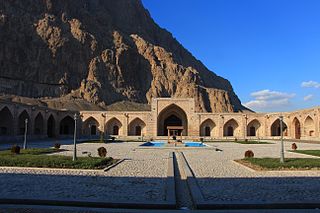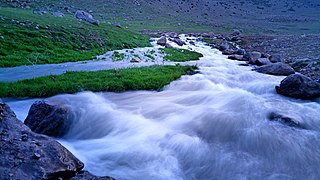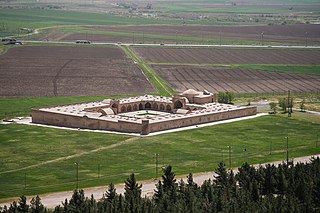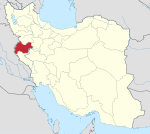
The Behistun Inscription is a multilingual inscription and large rock relief on a cliff at Mount Behistun in the Kermanshah Province of Iran, near the city of Kermanshah in western Iran, established by Darius the Great. It was crucial to the decipherment of cuneiform script as the inscription includes three versions of the same text, written in three different cuneiform script languages: Old Persian, Elamite, and Babylonian. The inscription is to cuneiform script what the Rosetta Stone is to Egyptian hieroglyphs: the document most crucial in the deciphering of a previously lost writing system.

Kermanshah Province is one of the 31 provinces of Iran. The province was known from 1969 to 1986 as Kermanshahan, and from 1986 to 1995 as Bakhtaran. The capital of the province is the city of Kermanshah. According to a 2014 segmentation by the Ministry of Interior, it is the center of Region 4, with the region's central secretariat located in Kermanshah. A majority of people in Kermanshah Province are Shia, and there are Sunni and Yarsani minority groups.

Bisotun is a city and capital of Bisotun District, in Harsin County, Kermanshah Province, Iran. At the 2006 census, its population was 2,075, in 527 families.

Behistun palace is a ruined Sassanid palace located in Bisotun, 20 kilometres (12 mi) from Kermanshah, Iran. It faces the cliff with the much older Behistun inscription and rock relief, across the ancient road running between Behistun mountain and Behistun lake. The palace has long been regarded in Persian tradition as a residence of Shirin, queen of Khosrau II, the Sassanid Shah of Persia who reigned from 590 to 628, shortly before the Muslim conquest of Persia. This connection is first documented, in surviving records, by early Islamic geographers, and is elaborated in various later stories and myths, as a fictionalized Shirin became an important heroine of later Persian literature, such as the Shahnameh. It is included in the UNESCO World Heritage Site of Bisotun.
Farrash is a village in Cham Chamal Rural District, Bisotun District, Harsin County, Kermanshah Province, Iran. As of the 2006 census, its population was 515, in 101 families.
Belverdi-ye Jadid is a village in Cham Chamal Rural District, Bisotun District, Harsin County, Kermanshah Province, Iran. At the 2006 census, its population was 1,880, in 460 families.
Belverdi-ye Qadim is a village in Cham Chamal Rural District, Bisotun District, Harsin County, Kermanshah Province, Iran. At the 2006 census, its population was 40, in 10 families.
Chambatan-e Olya is a village in Cham Chamal Rural District, Bisotun District, Harsin County, Kermanshah Province, Iran. At the 2006 census, its population was 483, in 117 families.
Gorgavand is a village in Cham Chamal Rural District, Bisotun District, Harsin County, Kermanshah Province, Iran. At the 2006 census, its population was 338, in 77 families.

Komeyjeh is a village in Cham Chamal Rural District, Bisotun District, Harsin County, Kermanshah Province, Iran. At the 2006 census, its population was 107, in 23 families.
Qeshlaq-e Olya is a village in Cham Chamal Rural District, Bisotun District, Harsin County, Kermanshah Province, Iran. At the 2006 census, its population was 70, in 17 families.
Shahrak-e Bisotun is a village in Cham Chamal Rural District, Bisotun District, Harsin County, Kermanshah Province, Iran. At the 2006 census, its population was 2,002, in 518 families.
Garmianak is a village in Shirez Rural District, Bisotun District, Harsin County, Kermanshah Province, Iran. At the 2006 census, its population was 287, in 69 families.
Sarmaj-e Karami is a village in Shirez Rural District, Bisotun District, Harsin County, Kermanshah Province, Iran. At the 2006 census, its population was 56, in 10 families.
Bisotun-e Bon Rud is a village in Dasht-e Arzhan Rural District, Arzhan District, Shiraz County, Fars Province, Iran. At the 2006 census, its population was 29, in 8 families.

The Parthian Stone is a relief located in the ancient site of Bisotun in Kermanshah Province, Iran, a UNESCO world heritage site. It shows a Parthian king with a bowl in his left hand. It also has an inscription, which identities the king as Vologases. Six kings named Vologases are known to have ruled the Parthian Empire, from 51 to the 220s CE. The inscription may refer to Vologases I or Vologases III. This historical heritage was listed in Iranian national heritages on 10 March 2002.
Temple of the Medes is a temple constructed by Medes located in UNESCO world heritage site the ancient site of Bisotun city in Kermanshah Province, Iran. this temple discovered by German Archeologists during 1963 till 1967. this historical heritage listed as Iranian national heritages on March 10, 2002.

The Shah Abbasi Caravansarai is a historical caravanserai located in Bisotun in Kermanshah Province, Iran. This caravanserai was listed as an Iranian national heritage on August 4, 1974. The caravanserai of Bisotun was constructed by order of Shah Abbas I. There is an inscription from Shah Suleiman.








